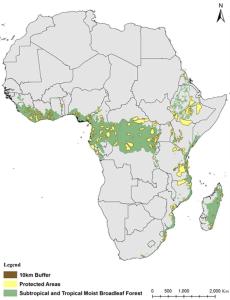
Subtropical and
Tropical Moist Broadleaf Forest of
Africa with 224 parks surrounded
by a 10-km buffer area. ©
2016 Society for Conservation Biology.
I’ve just read an interesting paper published in late 2016 in Conservation Biology that had so far escaped my attention. But given my interest in African conservation recently (and some interesting research results on the determinants of environmental performance for that region should be coming soon out of our lab), the work caught my eye.
The paper by Bowker and colleagues asked a question that has been asked previously regarding the ‘effectiveness’ of protected areas — do they succeed in limiting forest loss? While forest loss itself is not necessarily indicative of biodiversity erosion in any given area (for that, you need measures of species trends, etc.), it is arguably one of the most important drivers of species loss today.
The first set out to differentiate ‘effective’ from ‘ineffective’ protected areas, which was a simple binary variable related to whether there was less deforestation inside the protected area relative to comparable points outside (effective), or greater than or equal to deforestation outside (ineffective). The authors then related this binary response to a series of biophysical and social indicators.
First, a partially good news story emerged: over the last decade anyway, most (69%) of the 224 tropical protected areas they examined had less deforestation inside them than out. This is of course what one hopes, but it doesn’t really attest to the amount of total deforestation going on (e.g., both inside and out could have declining forest cover, albeit protected areas just slow down the rate a little).
One of the more interesting findings though was that the remoteness of the protected area had a completely opposite effect depending on whether it was ‘effective’ or ‘ineffective’; in ineffective ones, inaccessibility was a bad thing (i.e., it increased deforestation rate), whereas for ‘effective’ protected areas, inaccessibility was a good thing (less forest loss). This means that if you’re a baddie and the target protected area is not very well-governed, it’s probably safer to pilfer trees illegally if the area is nice and remote and away from prying eyes.
Newer protected areas also fared better, as did bigger ones (no surprises here), probably because older ones tended to be established without community support, and small ones just cannot buffer the damage happening outside them as as well as larger ones.
A final note — while I wouldn’t have approached the analysis quite the way the authors did (I think there are some issues of pseudo-replication and spatial autocorrelation, among others), I think the results are a nice addition to the literature on the effectiveness of protected areas.

